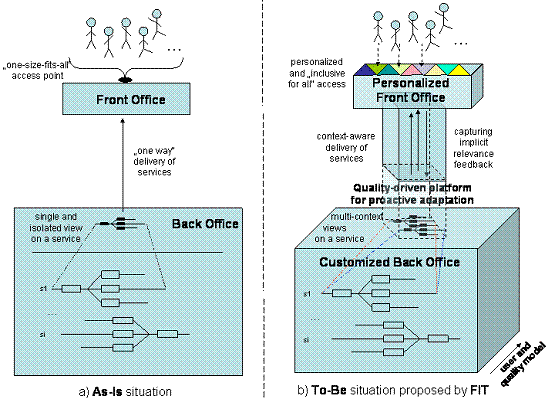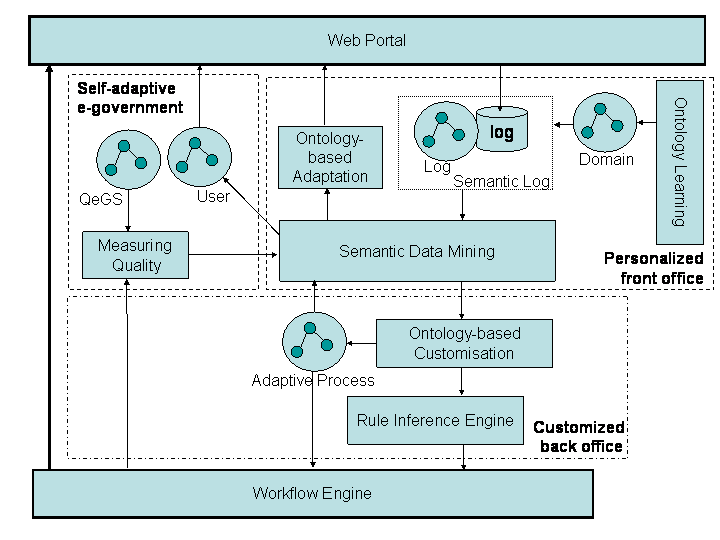January 2006–October 2008

#1.Project description
For e-government initiatives to succeed, public services should be organized in away to serve every citizen individually. Since citizens pose different access possibilities, skills and motivation, service delivery should be tailored to the widest possible end-user population. This adaptivity means that all citizens have access to the public services in a manner which is enabling and satisfying. It requires not only the personalized service delivery, but more important the extension of the service description by including dynamically changing citizens’ needs.The project partners are:
- Forschungszentrum Informatik an der Universität Kalrsruhe
- Planet S.A.
- Institute of Communication and Computer Systems, National Technical University of Athens
- Fachhochschule Solothurn Nordwestschweiz
- BOC Information Technologies Consulting GmbH
- CIM College d.o.o.
- SAP AG
- Ministry of Interior – Citizens Service Centres
- City of Vöcklabruck
- Ministry of Science and Environmental Protection of Republic of Serbia
The overall objective of FIT is to develop, test and validate a self-adaptive e-government framework based on semantic technologies that will ensure that the quality ofpublic services is proactively and continually fitted to the changing preferences and increasing expectations of e-citizens. FIT aims to
- Create a conceptual framework for realizing self-adaptive e-government (i) by taking into account users’ needs, domain knowledge and semantic descriptions of existing administrative processes and (ii) through ensuring continually improved services delivery, detecting new services and context-aware restructuring of existing services
- Increase citizens’ satisfaction by providing an intelligent and personalized front office through dynamically eliciting preferences of every user and proactive provision of context-sensitive and customized services/ information
- Increase the adaptivity of the back office through semantic modeling of customizable administrative processes and embedding these models in the daily work
- Enable knowledge sharing between front offices through semantic modeling of front offices best practice and efficient transferring of shared experiences to other front offices
- Pilot and evaluate the FIT platform in three public administrations in three different European countries. The evaluation of the project results will take into account technical, organizational and social aspects.

##As-is versus to-be situation
##Specific Project objectives
The overall objective of FIT is the development of methods and tools topublish e-government services on-line in a more efficient way in order toenable services accessibility for all users and to increase users’ satisfaction. The underlying methodology willensure that the quality of services isproactively and continually tailored to the changed preferences of e-users,which leads to the realization of a self adaptive e-government system. Thecustomized service delivery will pave a way to realize a vision of an empoweredcitizen who is able to configure e-government services adapted to his needs andplays an active role and participates in new services definition. Moreover, theFIT lays a foundation for a collaborative e-government web as a key request forknowledge creation, sharing and dissemination, for the efficient delivery ofpublic services and for the creation of public value. In that way the FITaddresses three of four key research challenges envisioned for the e-governmentin the EU in the next decade (i.e. knowledge-based, user-centered and networkede-government).

##High-level technical architecture of the FIT
More specifically, FIT aims to
[1]. Create a conceptual framework for realizing self-adaptive e-government that will enable continually improved services delivery, detection of new services and context-aware restructuring of existing services. The framework will be based on the analysis of users’ needs, domain knowledge and a semantic description of existing administrative processes.
This objective will be achieved through the delivery of:
(a) FIT ontology that models theconceptual dependencies between citizens, administrative processes, quality andan e-portal. It will be used as a backbone for defining the conceptualarchitecture of self-adaptive systems
(b) Conceptual model of theself-adaptive e-government system. The main components of the model areconsidered for this project to be: (i) collection of data about users’ behavior; (ii) analysis of data in thee-government context; (iii) discovery of knowledge about users’ preferences and(iv) embedding this knowledge in the modelof on-line services
(c) FIT Quality of e-GovernmentServices (QeGS) model and ontology to allow the specification of quality ofservices metrics and the relations between them concerning the quality ine-government services provided by public administrations.


##Technological components forenabling the FIT self-adaptive e-government
[2]. Providing e-citizens with knowledge-enhanced e-government portal (front office) that will be intelligent and more user-friendly through dynamically eliciting preferences of every user and proactive provision of context-sensitive and customized services/information.
This objective will be achievedthrough the delivery of the FIT adaptive front office platform comprising:
(a) methods and tools forsemi-automatic learning of a domain ontology that models the content of a frontoffice
(b) methods and tools for capturingusers’ interaction with afront office on the semantic level (i.e. semantic logging)
(c) methods and tools for mining thelog data by taking into account background knowledge (e.g. domain ontology andQeGS ontology)
(d) methods and tools to estimateand monitor the QeGS by supporting the continuous computation of metrics andregistering any deviations from the initial requirements
(e) methods and tools forontology-based adaptation of the structure and the content of a front officeaccording to the learned behavior patterns
[3]. Increase the flexibility/adaptivity of the back office through semantic modeling of customizable administrative processes and embedding these models in the daily work (i.e. in a workflow engine).
This objective will be achieved through the delivery of:
- semantic description of adaptive e-government services integrating ontology-based models with the dynamics of business rules
- inference engine for context-adaptive process execution
- methods and tools for embedding ontology-based description of adaptive e-government services into a workflow engine that is used in a back office

##Adaptive back offices
[4]. Enable knowledge- (experience-) sharing between front offices through development of the FIT methodology for semantic modelling of front offices’ best practices and efficient transferring of shared experiences to other front offices.
This objective will be achieved through the delivery of:
(a) Development of the FIT ontology for all pilots
(b) Semantic Mapping of rules about users‘ preferences between FIT ontologies
(c) Development and evaluation ofthe FIT methodology for creating adaptive e-government Web that encompasses e-government portals
##Conceptual architecture for transferring best practices between portals
- Pilot and evaluate the FIT platform in three public administrations in three different European countries. The evaluation of the project results will not be limited merely to the technical evaluation; rather, it will take into account both organizational and social aspects of the project.
##Closing the Semantic Loop in using an e-government system: The conceptual architecture of FIT according to the MAPE model

